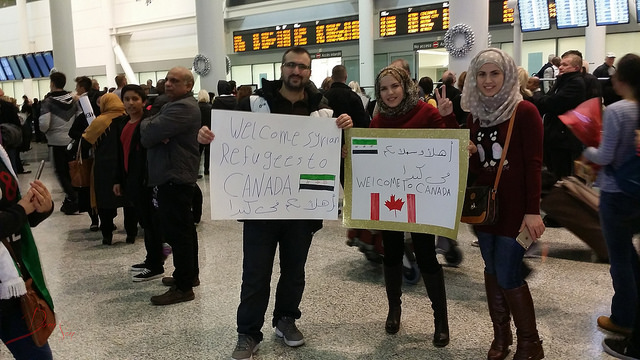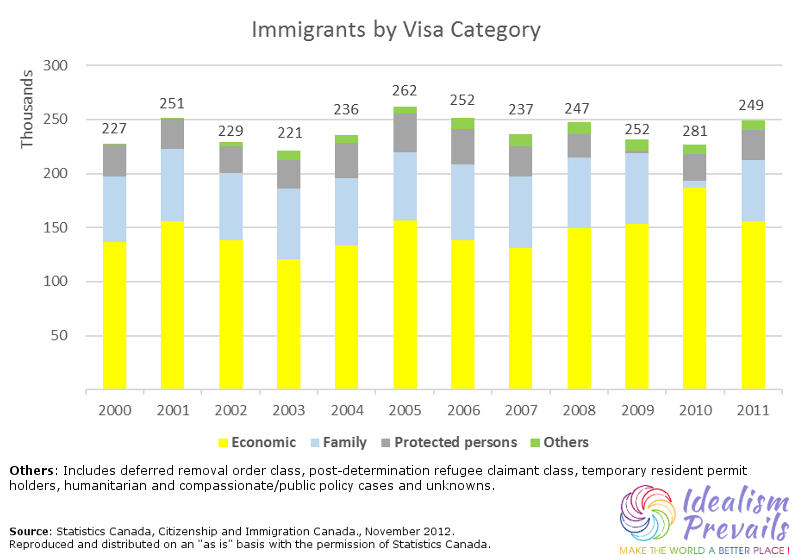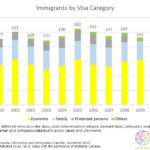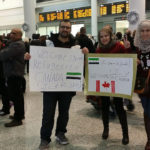Resettlement: orderly help for persons in distress

Imagine: a politician applying for the office of chancellor enters the election with the promise, that, should he be elected, he would admit 25,000 refugees from Syria as part of a resettlement program. And – he wins the election. This happened in November 2015 in Canada. Of course the Liberal Justin Trudeau made other promises as well, yet it is amazing, from a European’s persepective in particular, that one can succeed politically with such a slogan. And Trudeau delivered (with a small delay) – and wants to even double the number by the end of 2016th
Definition and claim
The term ‘resettlement’ means the permanent relocation of refugees in a third country, which grants them refugee status and provides them with integration options. The prerequisite for this program is, that the refugee has no chance of returning to their home country in the foreseeable future and that they are still threatened in a surrogate sanctuary (eg Turkey) or have no prospect of a dignified life there.
Basically the organizing of the resettlement programs resides with the UNHCR, which holds an annual conference (ATCR) of the participating states, to exchange information.
Resettlement in Austria – present but hardly used
For several years, Austria has had a resettlement program. In March 2012, the EU launched a joint initiative and has been granting financial support to the Member States. Nevertheless, little use has been made of it. In 2013 Austria decided to admit 500 Syrian refugees (following the 5000, which had been announced by Germany) into this program. The number was raised to 1500 one year later. By mid-2015 (ie before the refugee crisis), within two years a mere 780 spaces were occupied, due to delays on the part of Turkish and Austrian authorities. Given the refugee crisis developing thereafter, the achievement of the desired objective was no longer pursued.

Immigration country Canada
Canada is the territorial state with the highest immigration rate in the world. In Toronto, more than half of the population are immigrants, likewise in the state of Ontario. Canada’s annual immigration rate amounts to just under one percent of the population (which, if apportioned, is not far below the influx of refugees to Austria and Germany in 2015). The country has always seen itself as an immigration country and therefore also gathered experience in dealing with integration and its problems. After three years already, provided you fulfill the conditions, you can obtaining Canadian citizenship. The mayor of Calgary was the first Muslim incumbent in a major city on the North American continent. More than 80 percent of Canadians support immigration. There are transparent and therefore universally understandable rules. Germany, thanks to the long-standing refusal of the CDU / CSU is so far lacking such immigration law, but it is scheduled for 2017. Perhaps, cases like that of a Moroccan biologist with a doctorate, will then be a thing of the past.
There are basically three ways to “immigrate” to Canada:
The fastest path is by way of a family reunification with members already living in the country, as long as they vouch for the newcomer and have a steady income. As economic migrants – here either via the scoring system introduced in 1967 and only recently reformed (see chart), or via the Skilled worker regulation (which applies to 29 selected occupational groups) or as foreign workers for a limited time (usually only three to six months). The latter however, are not too welcome anymore after the latest economic boom’s fade out. Meanwhile, focusing on better educated immigrants has led to jobs for academics getting extremely scarce. The scoring system is flexible enough to continually adapt it to the given needs over the years.
Refugees account for between ten and twenty percent of the annual immigration. Since 1945, the country has received more than 800,000 refugees. The majority is now processed through the resettlement program of the UNHCR. When it comes to illegal immigration Canadians crack down hard. For the people they bring into the country, mostly at government expense directly from states such as Turkey or Jordan, they offer a long-term livelihood. They are picky and currently preferentially take families, women, children and people persecuted for their sexual orientation, which has already led to criticism: the young men stay behind and are then susceptible to radical ideologies.
The canadian resettlement plan
From selection to settling the refugees go through a five stage process:
*) Together with the UNHCR imperiled individuals with low security risk are selected, notified by SMS and – as long as they agree to resettlement – their data is recorded. The focus is on refugees in Lebanon and Jordan.
*) About 500 officers are sent to the Middle East to process visa applications and conduct personal interviews. The health check and security clearance (incl. Biometrics) are carried out overseas.
*) After being issued the permanent residence permit, the immigrants are taken to Canada by chartered aircraft, namely to Montreal and Toronto.
*) On arrival, the identity and health status are checked again. Those who are accommodated by private organizations are forwarded immediately. For state-supplied persons it is clarified whether they have relatives already in Canada and where there are currently open capacities in the school and living area.
*) The last step is about the integration of newcomers. Support granted from the outset, includes: “Orientation to life in Canada, access to healthcare, permanent housing, counseling, language services, schooling and other federal, provincial, territorial and municipal support services”. A dense network of organizations helps to overcome the difficult adjustment period in particular, and to make the refugees familiar with their new surroundings.
Civil society is involved in this process from the beginning, every Canadian can participate in various places. Both governmental, and private organizations manage the distribution of refugees across the country. There is a detailed plan of how many refugees are allocated to which municipality. Municipalities could volunteer, there was an oversupply of spaces, even though military bases had to serve as a temporary solution in an intermediate step.
Similarities to Europe
As in Europe, the population of Canada is of different opinions when it comes to refugees (see podcast), mainly because of the government’s rather tight timetable. (this is where half of the critic sees the main problems). There are occasional problems, however, not comparable in extent to Germany (burning homes for asylum seekers, incidents of New Year’s Eve in cologne). The understandable concerns of the local population regarding jobs and living space (with more composure than in European discussions) are addressed, misinformation is corrected.
Canada has so far been involved in the air strikes against the IS alongside the USA, but wants to retire from it in the future and focus on the training of fighters on location – a controversial move on the new government’s part. In the wake of this investment the country got into the crosshairs of Islamist in a few isolated incidents, there were attacks by radicalized Muslims and warnings are being voiced of the potential danger posed by refugees and Wahhabi influence on the Muslim community in Canada.
The difference lies in recruitment and experience
So everything just like we know it? Not quite.
On the whole, multiculturalism in Canada works. It is precisely because the nation has always understood itself as a multicultural melting pot. In Europe, many Germans want to stay Germans, many Frenchmen to remain Frenchmen, no major cultural changes are desired. Thus, the risk of immediate exclusion of any new arrivals is, of course, high. What happens when you leave immigrants to their own devices and parallel societies and ghettos form over the decades (which after all doesn’t happen overnight), can be observed in many European countries. Without bridges being built, integration does not work. These can – and indeed must – be associated with requirements from immigrants and refugees. But the offer of integration must be sincere, transparent and comprehensible. Which is not the case in most European countries, as the past decades have shown.
The most obvious advantage of Canada over Europe is, that owing to its distance from all trouble spots of the world, it hardly experiences unwanted immigration. This makes the management of the immigrants much easier. Nevertheless, they had to cope with very large flows of refugees in the past (end of the 19th and early 20th century) and they drew their lessons. They laid down clear rules, but never forgot the humanitarian aspect. Europe was not prepared for the influx of refugees in 2015 – for all too long, what was happening in Italy and Greece in recent years had been ignored successfully. Despite numerous warnings, the scale of the refugee flow was massively underestimated and the necessity for legal and organizational measures was missed. Immigration and its management (along with climate change) will probably be the defining issue of the coming decades for a demographically shrinking continent. It is time to accept this fact and to prepare for it, and do so at the European level and beyond. Walls and warships alone will not be the solution, any more than the dream of an unaffected island of the blessed. National solutions may appear promising short-termed, in the long run however they will fail, as they did for other major issues of our time.
Canada shows how to operate with clearly communicated rules on immigration and refugee policy. In the EU, it was hitherto not even possible to seek asylum without previously entering another EU country illegally. This grievance is likely to be resolved in the upcoming months. If one also manages to compose a structured resettlement program on the European level, which is then imparted to the refugees – including all rights, but also all obligations – future refugee movements might be handled better than was the case in 2015.
Translation from German: Serena Nebo
Credits
| Image | Title | Author | License |
|---|---|---|---|
 |
immigration-stats-by-visa-category | Michael Hössinger | CC BY-ND 4.0 |
 |
canada resettlement | Dominic Santiago | CC BY-SA 2.0 |
